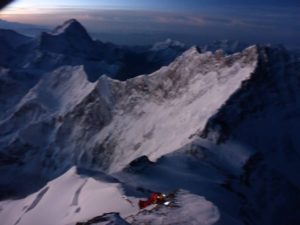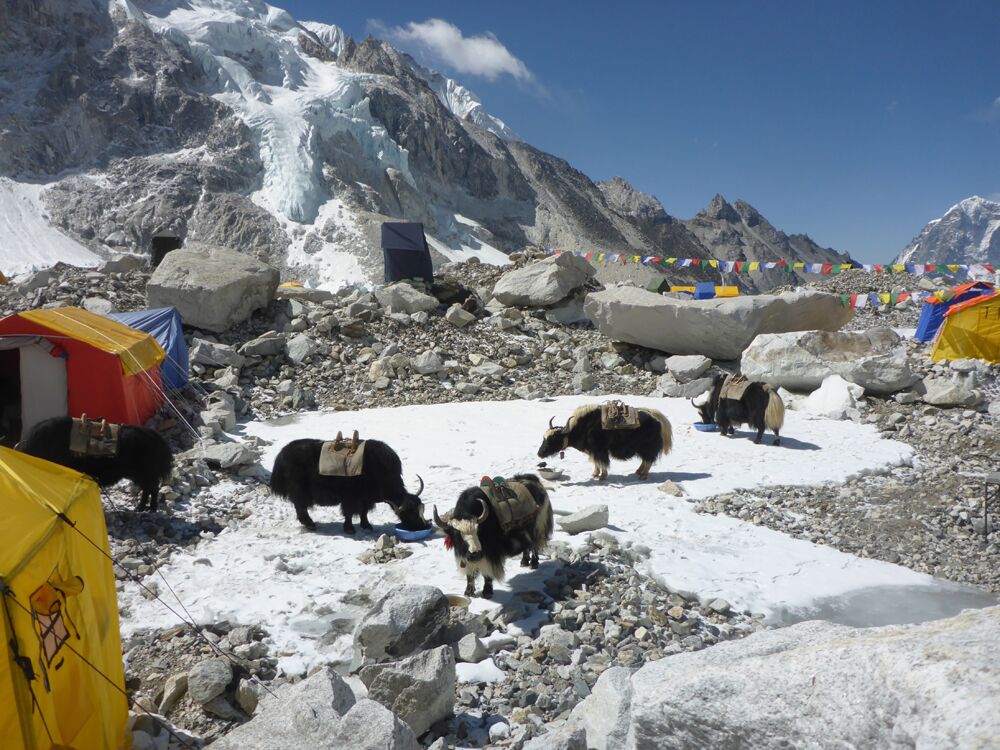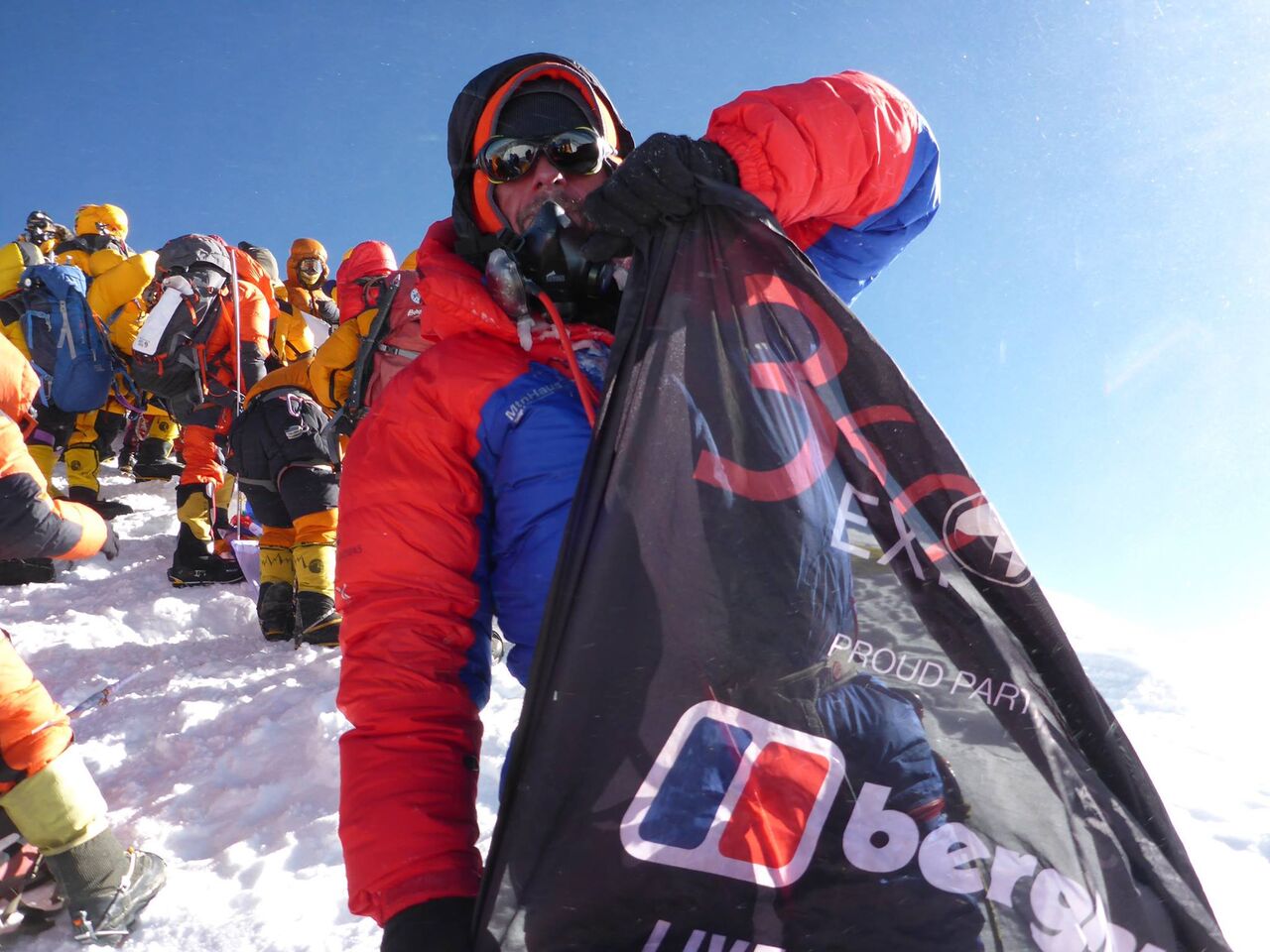We interviewed Rolfe about his thoughts on his climb to the top of Everest.
You have just come back from an incredible expedition to the top of the world. How are you feeling a week after returning home?
To be honest I am not feeling very much different coming back from this expedition than any other. It takes a few days to get out of “fog-land” and re-enter the crazy-ness that is the usual state of affairs at the Oostra’s but for me it’s always just a case of getting on with what’s next on the list that dominates my thinking.


We are keen to hear how it all was so let’s start at the beginning; where was your first Alpine climbing experience?
I started rock-climbing when I was 14 years old in Australia. It became to dominate my life and I could think of no better way of spending my days. Rock-climbing evolved into big-wall climbing which evolved into Alpine climbing. I did my first Alpine routes in New Zealand when I was 19 and felt that the combination of climbing ice and rock on huge routes was totally where it was at. I made up my mind there and then that I would try to make a career out of doing this activity.
Was it something you immediately fell in love with and immediately were good at or did it take time?
It was love at first sight. I never developed a taste for team sports and like the personal challenge and “head-game” that climbing offered.
Everest has been a long time in your planning; can you remember the first time you had the notion “one day I will be up there standing on top”?
Even though they’ll say otherwise every climber is curious about climbing the highest mountain on earth. Initially when I started expedition climbing we’d target mountains less high but much more technically satisfying to climb than Everest. That did the trick for a while but Everest is always in the back-ground. When we started 360 Expeditions many of our climbers began to want to climb the 7 summits. The progression of these summits leads to Everest so getting to guide this expedition with the clients I had worked on the other 6 became much more of a reality.
You guide exeditions all around the globe so did you use these as your training expeditions of did you specifically train for this in other ways?
The only training I did specifically for Everest was to pop pizzas in the oven and wring the tops of beer bottles. The aim here was to get as fat as possible in the shortest available time.. Just Prior to Everest I guided 5 high altitude expeditions and rock-climbed around the clock with my son Ollie. We managed to nail 4 grade seven routes that had been annoying the hell out of us. If anything I needed to “un-train” before going to Everest.
We know what happened last year (2015) on Everest, did this ever cause you to doubt the expedition when you were trekking in to Base Camp (BC)?
I have been very active as an Alpinist for over 25 years; spend a long time in the mountains and you will experience some pretty traumatic stuff. What happened on Everest last year was on a colossal scale but still I classed it in my mind as an un-predictable disaster that can happen to you when going on expeditions of this nature; 2014 saw a serac collapse that killed 14 Sherpas. If you let past events dominate your thoughts you’d be a nervous wreck. This kind of climbing is about the here and now and grabbing opportunities as they arise.
Let’s talk about BC. It’s a stunning trek just to reach Base Camp, one you have trekked many times; how did if feel this time walking in knowing you were set to go to the top?
On the walk in I was busy organising and thinking about climbing Island peak and Lobuche East. We climbed these 2 beautiful mountains to get acclimatised for Everest. I really didn’t think about Everest that much during the walk in.


You brought an 8 kilo leg of ham and a bottle of whisky(!), what other luxuries where brought to BC by other climbers?
We shared a basecamp with a friend and fellow guide called Tim Mosedale who in renowned for taking some pretty tasty stuff with him on expeditions. This year Tim brought a variety of cheeses, chillies and pickles. Jo not to be out-done brought bags of beef-jerky, salamis and a range of crisps and nuts. All good morale food for whiling away the basecamp blues.
What did you miss and what would you bring up if you were to climb Everest again?
I don’t really have the need for comfort food or luxuries. My life is about going on one expedition after the next and the formula I have developed to make life a little less arduous has been honed well over the years. I always that no matter how shitty a situation gets the sun always shines again.
The mood in Base Camp has been described as rather a macho scene and quite competitive; what were the highs and lows of this home from home?
There were some pretty big name climbers at basecamp (Male and Female) but the atmosphere was actually very chilled. I knew many of the American and New-Zealand veterans from the climbing circuit and found that when we got together for a drink that conversation would be about anything but mountains and work. Sure we’d compare the forecast and strategy but soon things would get lively and we’d end up talking about the funny things we’d seen that day or the antics of the people around you. It was fun to hang out with these kind of people as they are very similar to my friends at home.
Did you listen to music and if so which song did you listen to when at your low points?
I never had to much of a chance to listen to Music but usually have a little dose of metal or punk as a night time lullaby.
The ice fall is notoriously known for being the most dangerous part of the climb, was it this you feared the most?
The ice-fall IS the most dangerous part of the climb. We minimised the dangers by going through before the sun-rose and by climbing through as quickly as possible. In this place it is a good thing to have some controlled fear to drive you through. I have a lot of respect for the ice-fall doctors who spend their days pushing through the route and then maintaining it.
The summit was obviously your goal; did you have to set daily goals to get you there or was the focus only on reaching this pinnacle?

The summit is always the main focus but I build a day to day strategy to enable my client to reach it. The variables of the climbing itself and my clients fitness and ability to cope with the day to day pressures varied enormously. On top of this external pressures and changes led us to revise the plan around a million times. There are sometimes so many changes on a day to day basis that it’s a back to square one scenario when you go to sleep at night. But starting afresh each morning you look up at that summit and you know you’ll get there.
Obviously we (the public) always think of Everest as being freezing but you had a day where you literally roasted in your down suit when climbing to Camp 3; did you change your strategy the next time you climbed this section?
The funny thing about mountains is that I have had both my hottest and coldest moments there on the same day. The trick for coping with the heat is to leave early in the morning and to move quickly between camps.
At Camp 3 and the South col (Camp 4) you cooked yourselves; what was the menu or was it all based around jelly babies (which we understood got you to the summit and back again)!
I had no appetite on the South Col and focussed on hydration. Sugary brew after sugary brew. I did surprise myself and managed to neck down a large bowl of very liquid porridge half an hour before we set of for the summit. All of a sudden that became the right thing to do. I tried to eat a smoked pork sausage but I gagged on the thing and left it behind.
When at the south col on your second summit weather window, the wind suddenly picked up and blew a storm making it a freezing and very uncomfortable afternoon. How did you manage to keep positive?
The forecasting was quirky to say the least but there was a reliable pattern that had established over the previous days. The weather we experienced was more or less expected. The up-dates were for increasing winds to hit the summit at our predicted summit time. There is a cut of point for when winds become too strong to climb but the forecast was for gusts not static winds. We talked about another day’s delays but decided to attempt the summit on schedule as the only variable that had really changed was wind speed. We could cope with more cold better than the forecasted snow as we had the right kit and were on oxygen.
On the 18th May at 8pm you set out for your summit attempt. There were a fair few teams with the same idea; how this affect your climb?
The main problem with the teams ahead was their in-competence at handling the rock sections. Every climber stuck behind these teams (who had purposely left ridiculously early because they’d been so slow climbing to the south col) began to freeze. I am convinced a lot of the cold injuries that occurred during this summit bid could have been avoided had these people not been on the mountain. We had an exit strategy and the thought to bail out did cross my mind at one stage but by then we’d managed to by-pass the slowest climbers and the sun began to rise. The sun-rise was a hugely positive thing for me and we could see the summit not too far away.


You reached the summit on the 19th May at 06:45am; what was your very first thought and tell us a little of what it was like?
My initial thought was to check on Jo. She looked a lot more chirpy than I felt so I could relax a little. I had a list of images to take and calls to make but these notions went out the window due to both battery failure and me taking my mask off. As soon as I had my mask off a feeling of disappointment washed over me. My thoughts were of how busy it was and how cold I was. As soon as the gas was back on I thought about calling Izabella (my daughter) to make a joke about the world being really round and to talk to my son about next time doing this climb together. I did have a good look around and the scenery stretching out beneath us felt over-whelming. But soon I wanted to get down as quickly as we could.
You stayed at Camp 2 to attempt Lhoste after having climbed Everest but this wasn’t possible, once this decision had been made how did you feel?
As we were climbing to the Balcony we noticed the lights of a string of climbers moving up Lhotse. These were climbers moving up behind a fixing team bringing up ropes for them. When we reached the South Summit we noticed that the whole group had turned around hundreds of meters from Lhotse’s summit. It transpired that there had been a fatality amongst the fixing team when one of their lead Sherpas had lost his balance pulling up on an old bit of fixed line. This development and pure exhaustion when we returned from the summit back to the South Col made Jo reconsider continue doing the double. We returned to camp 2 that same evening and Jo recognised that she was in no state to re-ascend to camp 3 (and beyond) over the next few days. I stuck it out wanting to see how things developed with another 2 teams attempting Lhotse from the south col over the next few days and made a plan to attempt this mountain from Camp 3. As things turned out everyone else abandoned their attempts also as conditions remained dangerous and no ropes were ever pushed up. Once these decisions had been made I was very happy to go with the flow and descend back to basecamp to begin the walk home.
What were your feelings when popping out of the ice fall that one last time walking into BC having reached the top of the world?
Once you are out of the icefall a feeling of it all being over washes over you. I sat down on a chunk of ice for over an hour to get my head back together and to reflect on all that had happened during the last weeks. It was good to be able to find this peace before continuing down to EBC.
What did you do, have a cuppa, a beer or whisky (or all three!)?
Because I waited at C2 and re-climbed part of the way to C3 when I arrived at basecamp most teams (including Jo) had already choppered out. This just left me, Henry (our BC manager) and a bottle of Scotch.
On reflection, physically and mental how does this compare to Aconcagua – a major stepping stone to attempting Everest?
If climbing the seven summits then it is important to climb Aconcagua (and Denali) before attempting Everest. Both mountains are very different from each other in character, terrain, complexity and what is required physically and mentally to summit. From a guides perspective Aconcagua is more physically demanding as the teams tend to be self-sufficient and un-supported by Sherpas. From a physical point of view you are faced with a lot less choices as to how you climb Aconcagua than Everest. On Everest oxygen is available to use from basecamp if you want it and you do not have to carry anything between camps if you chose not to. Sherpas pitch your tent and there is a catering crew at camp 2. Mentally Everest is a lot more demanding because of the added extremes of altitude and the icefall. Both mountains are bad weather magnets so if you are prepared to sit out some gnarly stuff than the inside of a tent is pretty much the same on both.
Rolfe’s (your) voice clip from the summit was full of elation telling us all how spectacular it really was and was so worthwhile in pushing hard over the years to get there. What do you say to folk who feel it’s a crowded mountain?
I always used the same argument to justify not being interested in climbing Everest; the mountain is too crowded. I still have the same opinion, there are many people attempting the mountain who would struggle to climb Aconcagua and on summit day there were undoubtedly cold-injuries caused to capable climbers caught up waiting for the in-capable “climbers”. Now whilst this detracted from my overall experience working as a guide and making the right calls it did not supress my personal feeling of “Holy shit! We’re actually climbing Mount Everest here!!”


So the million-dollar question; what’s next?
My next gigs are to attempt my 4th seven summit for the year; Elbrus (june) and my 3rd 8000 meter peak for the year; Cho Oyu. (August)